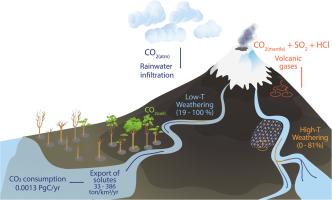The contribution of continental volcanic arcs to global weathering fluxes: Insights from the Southern Andes
IF 4.8
1区 地球科学
Q1 GEOCHEMISTRY & GEOPHYSICS
引用次数: 0
Abstract
Rivers draining volcanic regions are key to the global flux of solutes towards the ocean and in the consumption of atmospheric CO2 through silicate rock weathering. In active volcanic regions, degassing and hydrothermal inputs can be an additional supply to weathering fluxes from high-temperature water-gas-rock reactions. Multiple surface hydrothermal manifestations and substantial degassing characterize continental volcanic arcs, and their contribution to the silicate rock weathering budget has been overlooked in comparison with volcanic islands. Here we use as a model the Southern Andes for investigating weathering of continental volcanic arcs. The Southern Andes is one of the most globally active volcanic provinces with >200 hydrothermal manifestations, high rainfall > 2000 mm/yr, numerous catchments feeding larger rivers draining toward the Pacific Ocean, and predominantly mafic volcanic rocks. We sampled twenty-two rivers and sixteen hot springs at high and low discharges from different volcanic watersheds in the Southern Andes. We found that more than half of the rivers were influenced by hydrothermal inputs using hydrothermal tracers Ge/Si and δ11B independently, with both tracers agreeing in most cases. Furthermore, using the chloride budget and Ge/Si ratios as high-T° weathering tracers we estimate that influence of hydrothermal activity on the dissolved silicate load ranges from 0.2 to 81 % with a mean of 11 %. As a result, we present a first estimation of chemical weathering fluxes in the Southern Andes, with silicate weathering export rates ranging from 33 to 386 ton/km²/yr across the studied catchments. Using the silicate export rates, we calculate that the total carbon consumption via weathering of the total Southern Andes area is 0.11 × 1012 mol/yr. This figure is equivalent to 0.0013 Pg C/yr which amounts to around 1 % of the global carbon consumption by the weathering of silicate rocks on the continents. This study is the first assessment of chemical fluxes in rivers of the Southern Andes and underscores the importance of studying large-scale continental volcanic arcs to improve our understanding of the feedback of silicate rock weathering in the global carbon cycle.

大陆火山弧对全球风化通量的贡献:来自南安第斯山脉的见解
流经火山地区的河流是全球溶质向海洋流动的关键,也是硅酸盐岩石风化过程中大气二氧化碳消耗的关键。在活火山地区,脱气和热液的输入可以作为高温水-气-岩反应的风化通量的额外供应。陆相火山弧具有多种地表热液表现和大量脱气特征,与火山岛相比,它们对硅酸盐岩石风化收支的贡献被忽视了。这里我们使用南安第斯山脉作为模型来研究大陆火山弧的风化作用。南安第斯山脉是全球最活跃的火山省之一,有200个热液活动,年降雨量高达2000毫米,众多的集水区为流入太平洋的大河提供水源,主要是基性火山岩。我们对来自南安第斯山脉不同火山流域的22条河流和16个温泉的高低流量进行了采样。利用热液示踪剂Ge/Si和δ11B,我们发现超过一半的河流受到热液输入的影响,这两种示踪剂在大多数情况下是一致的。此外,使用氯化物收支和Ge/Si比率作为高t°风化示踪剂,我们估计热液活动对溶解硅酸盐负荷的影响范围为0.2%至81%,平均为11%。因此,我们提出了南安第斯山脉化学风化通量的第一个估计,在研究的集水区,硅酸盐风化出口率从33到386吨/平方公里/年不等。利用硅酸盐出口速率,我们计算出南安第斯山脉地区的风化总碳消耗为0.11 × 1012 mol/yr。这个数字相当于0.0013 Pg C/年,相当于全球大陆硅酸盐岩石风化所消耗的碳的1%左右。这项研究首次评估了南安第斯山脉河流中的化学通量,并强调了研究大型大陆火山弧对提高我们对全球碳循环中硅酸盐岩石风化反馈的理解的重要性。
本文章由计算机程序翻译,如有差异,请以英文原文为准。
求助全文
约1分钟内获得全文
求助全文
来源期刊

Earth and Planetary Science Letters
地学-地球化学与地球物理
CiteScore
10.30
自引率
5.70%
发文量
475
审稿时长
2.8 months
期刊介绍:
Earth and Planetary Science Letters (EPSL) is a leading journal for researchers across the entire Earth and planetary sciences community. It publishes concise, exciting, high-impact articles ("Letters") of broad interest. Its focus is on physical and chemical processes, the evolution and general properties of the Earth and planets - from their deep interiors to their atmospheres. EPSL also includes a Frontiers section, featuring invited high-profile synthesis articles by leading experts on timely topics to bring cutting-edge research to the wider community.
 求助内容:
求助内容: 应助结果提醒方式:
应助结果提醒方式:


